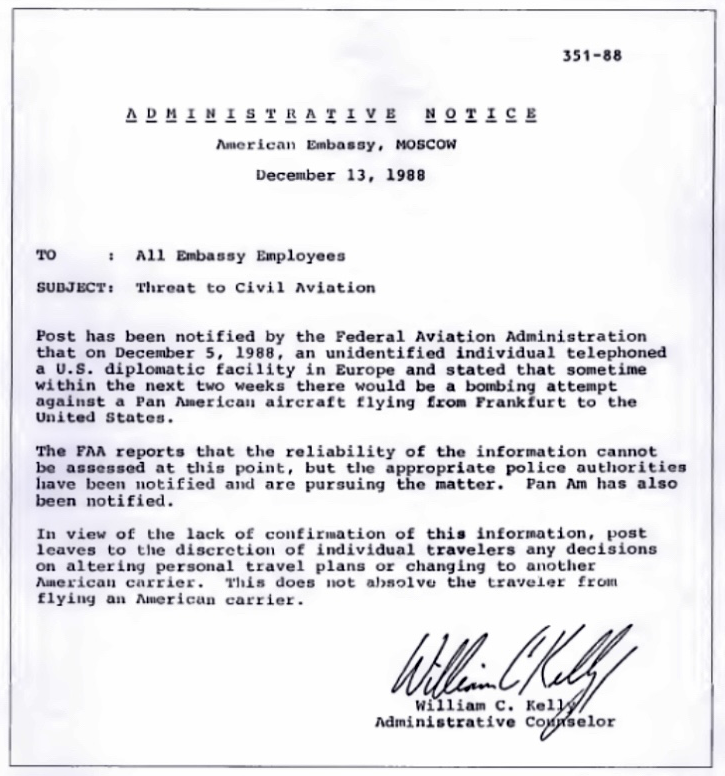by Richard Gilbert
On December 12, 2022, the U.S. Department of Justice announced the arrest and detention of Abu Agila Mohammad Mas’ud Kheir Al-Marimi (Mas’ud), 71, of Tunisia and Libya, the suspected maker of the bomb that destroyed Pan American Flight 103 over Lockerbie, Scotland, 34 years earlier.
In addition to being a sharp reminder of the tragic deaths of 270 innocent persons in 1988, the announcement of Mas’ud’s arrest also brought home for me decades-old questions about what was “known in advance” and the birth of the U.S. government’s No Double Standard policy.
The news about Mas’ud sent my mind swirling back 34 years to the discussion at our weekly section heads meeting in Moscow in mid-December 1988; I participated in these Country Team meetings as embassy Press Attaché. That day, Administrative Counselor Bill Kelly reported receiving an unclassified Federal Aviation Administration (FAA) “Threat to Civil Aviation” warning, sent to several embassies. By citing Pan American specifically, the warning had special resonance for the official Moscow community. At the time, our usual route to the U.S. under required “Fly America” rules put us on Pan American’s daily flight to Frankfurt or London, then onward to the U.S.
The Country Team participants unanimously agreed that the FAA warning, despite its lack of specificity, was of more than routine interest. By the following day, the embassy issued an Administrative Notice throughout the embassy. We in the press office made sure that the notice was prominently posted in the embassy cafeteria, a place where the broader American community—business reps, academic exchange program grantees, and the resident Moscow U.S. press corps—had access.
Arriving in the embassy a few days later, early on December 22, we were stunned to hear the terrible news of the overnight destruction of the Pan Am flight over Scotland. Within minutes after reaching my press office desk, the phone rang. It was ABC’s Moscow bureau chief, Walter Rodgers. “Hey, Richard,” Walter said, “do you still have that notice posted in the cafeteria? Do you mind if we send over a crew to take some video for ‘Good Morning, America’?”
“Sure,” I replied, without hesitating, “I think it’s still there. No problem. I’ll meet you downstairs.” The crew came and went, and the hours passed routinely, until 3:00 in the afternoon—7:00 a.m. on the east coast. In New York, “Good Morning, America” led with Walter’s video and “the U.S. Embassy in Moscow’s advance warning” of the Lockerbie bombing. Within seconds, switchboard hell broke loose in our little eighth floor press warren.
The calls came from everywhere: all the Moscow press bureaus, global and U.S. newspapers, European and Asian TV networks. The questions were much the same. What did Embassy Moscow know and when did they know it? Did the embassy post an advance warning of the attack? How do we get a copy of the admin notice? We tried carefully to stick to the facts as we knew them: yes, we posted an FAA threat warning; no, it did not contain a specific warning about Pan American 103; yes, I’ll read the Admin Notice to you; and, check with the FAA for the complete threat warning text.

From Embassy London, which was fielding a huge media storm, came a plaintive, “I hope you’re not saying anything in Moscow.” Regrettably, I replied, that train left the station two hours ago. Smartly, the State Department’s Press Office got through to Moscow on the secure line to review the facts as we knew them and to coordinate the department’s response for the forthcoming daily briefing. Thankfully, there were no recriminations from the department over our role in posting the notice.
Eventually, the chaos of the day abated as fresh stories about what happened over Lockerbie claimed the headlines, and the news focus moved away from Moscow. Much later, questions arose about the suitability of Moscow’s public release of the FAA threat warning and about whether the action ran counter to FAA handling guidance. The provenance of the anonymous telephone call to “a U.S. diplomatic facility” (later revealed to be Helsinki) that gave birth to the original threat has, to my knowledge, never been fully explained or clarified.
One result of Embassy Moscow’s handling of the FAA threat warning 34 years ago has been of long-lasting and enormous public importance. Today, we who were in the Moscow press office then take no small satisfaction in knowing that our actions of openness and honesty in December 1988 undoubtedly led to the creation and implementation of the “no double standard” policy, a law which prohibits “selective notification of a threat to civil aviation” to only selected potential travelers. Now codified in the State Department’s 7 FAM 050, the policy has become the standard guide for public information for both government and many private businesses.![]()

Richard Gilbert, a career USIA officer, served as U.S. Embassy Press Attaché in Moscow 1987-89, after which he resigned to accompany his FSO spouse, Carol Urban, during her career. This is an updated version of an article that appeared in the May 1990 issue of the Foreign Service Journal.
